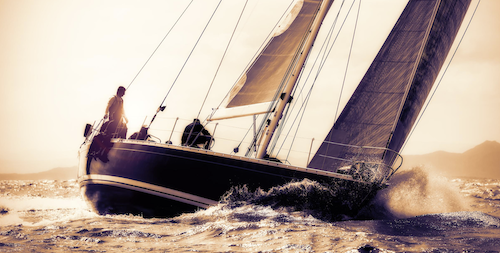How a Sail Inverts Its Shape
A sailboat’s mainsail acts like a wing. Wind flowing over it creates horizontal lift. Meanwhile, water exerts forces on the boat’s hull and keel. Skilled sailors can adjust tension and position the sail to ensure that the interplay of these forces always generates a net forward component, even when sailing at an angle into the wind. To reach upwind destinations, sailors pursue a zigzag course punctuated by a maneuver called tacking: rapidly switching the boat’s direction, which flips the sail into a mirror-image shape. In simulations, Christiana Mavroyiakoumou of New York University and Silas Alben of the University of Michigan analyze when tacking flips the sail into the optimal shape—and when it doesn’t [1].
Mavroyiakoumou and Alben coupled a membrane model with a fluid model to investigate the tacking maneuver. A flexible membrane was initially angled at 0o–20o relative to a steady background flow, causing it to become curved. Then, the membrane’s angle was flipped so the flow came from the other side. The researchers examined which of the model’s parameters influenced whether and how the membrane assumed its mirror-image shape in response to the new wind direction.
The membrane was most likely to flip for larger values of steady parameters—stretching rigidity, tension, and final angle of attack, that is, the angle between the wind and the sail. How long the flip took depended on the speed and acceleration of the tacking maneuver as well as the membrane mass. A membrane with sufficient mass maintained its momentum long enough to flip; however, it took longer to settle to a steady shape.
The study provides insights not just for sailors but also for those who design membranes that direct and propel a moving vehicle, such as autonomous sailing robots.
–Rachel Berkowitz
Rachel Berkowitz is a Corresponding Editor for Physics Magazine based in Vancouver, Canada.
References
- C. Mavroyiakoumou and S. Alben, “Sail dynamics during tacking maneuvers,” Phys. Rev. Fluids 10, 073901 (2025).




